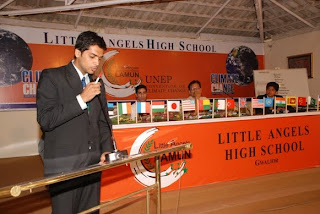Debating is a major part of Model United Nations, but MUN debates are always centred around resolutions. A resolution is one long sentence declaring a nation’s opinion concerning a topic, and the actions it intends to take.
A resolution consists of both preambulatory clauses and operative clauses. Preambulatory clauses establish a nations motivation, while operative clauses determine what action to take. These resolutions will form the primary documents at the conference. Delegates will spend their time at LAMUN - 2009 debating and amending resolutions that have been brought by delegates; and also, in the informal negotiating periods, lobbying and gathering support for them. Experienced delegates are strongly encouraged to write resolutions for the LAMUN conference.
Any resolution you write must be in accordance with your country’s stated policy. Remember that a resolution is a text setting out problems and suggested solutions in a formalised way. Resolutions should state at the top of the page the Committee, the subject matter, the submitter, and leave space for the co-submitters. Resolutions should be submitted by one or two country/ies and co-submitted by at least six others, before they can be debated.
Format
The format of a resolution is strict, and certain rules must be followed. A resolution, as has already been noted, is divided into perambulatory clauses and operative clauses. The preamble contains the background to the problem and should be kept fairly short (1-3 clauses is sufficient), as the background will be covered in the debate itself. The preamble has little effect on the purpose of the resolution. The arguments for the action you are proposing, and the reasoning behind the calls for action should be in the operative clauses. To gauge the real meaning of a resolution, look at the operative clauses first, and consider how they might be adapted to meet your country's needs.
A resolution is contained within one sentence. At the end of each perambulatory clause there is a comma; at the end of each operative clauses there is a semicolon, the last clause is ends with a full stop.
Operative clauses must be numbered. Clauses may be divided into sub-clauses labelled (a), (b), etc.
Resolution Introductory Phrases
Each clause should start with a verb in the following way (though this list is not exhaustive):
Preambulatory Clauses:
Affirming
Alarmed by
Approving
Aware of
Believing
Bearing in mind
Confident
Contemplating
Convinced
Declaring
Deeply concerned
Deeply conscious
Deeply convinced
Deeply disturbed
Deeply regretting
Desiring
Emphasising
Expressing its appreciation Expressing its satisfaction
Fulfilling
Fully aware
Fully believing
Further deploring
Further noting
Further recalling
Guided by
Having adopted
Having considered
Having considered further
Having denoted attention
Having examined
Having heard
Having received
Having studied
Keeping in mind
Noting Noting with approval
Noting with deep concern
Noting with regret
Noting with satisfaction
Observing
Realising
Reaffirming
Recalling
Recognising
Referring
Recalling
Seeking
Taking into account
Taking into consideration
Taking note
Viewing with appreciation
Welcoming
Operative Clauses
Accepts
Affirms
Approves
Authorises
Calls
Calls for
Condemns
Congratulates
Confirms
Considers
Declares accordingly
Deplores
Designates
Draws the attention
Emphasises
Encourages
Endorses
Expresses its appreciation
Expresses its hope
Further invites
Further proclaims
Have resolved
Notes
Proclaims
Reaffirms Recommends
Reminds
Regrets
Requests
Solemnly affirms
Strongly condemns
Supports
Trusts
Takes note of
Transmits
Urges
Sample Resolution
The General Assembly of the United Nations,
Noting Article One of the Universal Declaration of Human Rights, which states that “All beings are born free and equal in dignity and rights”,
Aware that economic embargoes cause great damage to nations, both to the individuals within the nations, and to the wider social structure,
Bearing in mind paragraph 70 of the Secretary-General's 1995 report on the work of the United Nations, which stated, "Sanctions … raise the ethical question of whether suffering inflicted on vulnerable groups in the target country is a legitimate means of exerting pressure,
Calling the attention of member states to the Vienna Declaration and Programme of action which affirms that food should not be used as a tool for political pressure,
Convinced that it is wrong and immoral for any country to penalise another through prejudice, because they disapprove of their government,
Believing that it is only through building firm trading links, and not through a policy of hatred and intolerance that a lasting peace between nations can be achieved,
1. Calls upon all member states to reconsider their position over all sanctions, and particularly the sanctions on Iraq and Cuba;
2. Suggests that the sanctions against the above named countries be gradually relaxed, with the aim of reinstating the infrastructure, education system and medical care of both member states;
3. Expresses its hope that the sanctions will be fully lifted within eight years;
4. Urges the United Nations to send medical aid to both countries, to alleviate the suffering of the thousands of civilians, especially to pregnant and nursing mothers, and children;
5. Strongly recommends that the first sanctions to be relaxed on oil in the case of Iraq, and on sugar in the case of Cuba, so that the countries may use the profits from their primary exports to:
a. invest in the socio-economic structure of their nations, in order to revive their economies,
b. provide humanitarian aid, specifically food and medicine, to their population,
c. pay teachers and other professionals to return to work, so that the alarming drop-out rate at elementary and secondary schools may be remedied, to provide a basic education for the future generation;
6. Suggests that this process be monitored by the UN and other nations that would be effected, especially those in the Middle East;
7. Encourages all member states to endeavour to trade fairly with these countries in particular, and troubled regions in general, so that through mutual trade and increased prosperity, lasting peace and friendly relations between countries will ensue.




